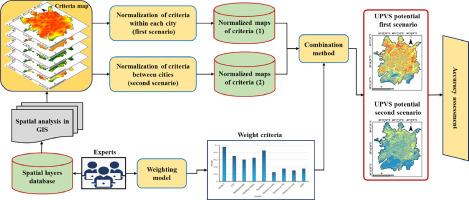Exploring the climatic conditions effect on spatial urban photovoltaic systems development using a spatial multi-criteria decision analysis: A multi-city analysis
IF 10.5
1区 工程技术
Q1 CONSTRUCTION & BUILDING TECHNOLOGY
引用次数: 0
Abstract
Identifying suitable locations for urban photovoltaic systems (UPVS) is crucial for achieving sustainable energy objectives and designing smart, eco-friendly cities. This study assesses the potential for UPVS expansion in eight cities across different climatic zones in Iran using a spatial multi-criteria decision-making method. Two scenarios were analyzed: the first compared spatial potential within each city, and the second compared potential between cities. The findings indicate that rooftops of the tallest buildings in densely populated areas, especially those with high solar energy output and sky view factor, hold the greatest potential for UPVS development. These locations are often near parks, commercial centers, and road networks. In the first scenario, Ardabil (5.70%), Gorgan (4.65%), Mashhad (5.46%), Tehran (8.10%), Kermanshah (5.76%), Shahrekord (3.41%), Kerman (8.67%), and Zahedan (8.56%) show significant potential for photovoltaic development. In the second scenario, cities in hot, dry climates like Zahedan and Kerman exhibit greater potential compared to cities in moderate, humid climates like Ardabil and Gorgan. Based on the analysis of this scenario, Ardabil (0.04%), Gorgan (1.49%), Mashhad (5.58%), Tehran (5.06%), Kermanshah (0.00%), Shaherkord (0.03%), Kerman (21.70%) and Zahedan (39.11%) showed a very high potential for UPVS development. The results of this study offer valuable insights for urban solar energy planning.

利用空间多标准决策分析探讨气候条件对城市空间光伏系统开发的影响:多城市分析
确定城市光伏系统(UPVS)的合适位置对于实现可持续能源目标和设计智能、生态友好型城市至关重要。本研究采用空间多标准决策方法,对伊朗不同气候带八个城市的 UPVS 扩展潜力进行了评估。研究分析了两种方案:第一种方案比较了每个城市内部的空间潜力,第二种方案比较了城市之间的潜力。研究结果表明,人口稠密地区最高建筑的屋顶,尤其是太阳能输出和天空视角系数较高的屋顶,具有最大的 UPVS 开发潜力。这些地点通常靠近公园、商业中心和道路网络。在第一种情况下,阿尔达比勒(5.70%)、戈尔甘(4.65%)、马什哈德(5.46%)、德黑兰(8.10%)、克尔曼沙赫(5.76%)、沙雷科德(3.41%)、克尔曼(8.67%)和扎赫丹(8.56%)显示出巨大的光伏发展潜力。在第二种情况下,扎黑丹和克尔曼等气候炎热干燥的城市与阿尔达比勒和戈尔甘等气候温和潮湿的城市相比,表现出更大的潜力。根据对这一情景的分析,阿尔达比勒(0.04%)、戈尔甘(1.49%)、马什哈德(5.58%)、德黑兰(5.06%)、克尔曼沙赫(0.00%)、沙赫科德(0.03%)、克尔曼(21.70%)和扎黑丹(39.11%)显示出极高的 UPVS 发展潜力。这项研究的结果为城市太阳能规划提供了宝贵的启示。
本文章由计算机程序翻译,如有差异,请以英文原文为准。
求助全文
约1分钟内获得全文
求助全文
来源期刊

Sustainable Cities and Society
Social Sciences-Geography, Planning and Development
CiteScore
22.00
自引率
13.70%
发文量
810
审稿时长
27 days
期刊介绍:
Sustainable Cities and Society (SCS) is an international journal that focuses on fundamental and applied research to promote environmentally sustainable and socially resilient cities. The journal welcomes cross-cutting, multi-disciplinary research in various areas, including:
1. Smart cities and resilient environments;
2. Alternative/clean energy sources, energy distribution, distributed energy generation, and energy demand reduction/management;
3. Monitoring and improving air quality in built environment and cities (e.g., healthy built environment and air quality management);
4. Energy efficient, low/zero carbon, and green buildings/communities;
5. Climate change mitigation and adaptation in urban environments;
6. Green infrastructure and BMPs;
7. Environmental Footprint accounting and management;
8. Urban agriculture and forestry;
9. ICT, smart grid and intelligent infrastructure;
10. Urban design/planning, regulations, legislation, certification, economics, and policy;
11. Social aspects, impacts and resiliency of cities;
12. Behavior monitoring, analysis and change within urban communities;
13. Health monitoring and improvement;
14. Nexus issues related to sustainable cities and societies;
15. Smart city governance;
16. Decision Support Systems for trade-off and uncertainty analysis for improved management of cities and society;
17. Big data, machine learning, and artificial intelligence applications and case studies;
18. Critical infrastructure protection, including security, privacy, forensics, and reliability issues of cyber-physical systems.
19. Water footprint reduction and urban water distribution, harvesting, treatment, reuse and management;
20. Waste reduction and recycling;
21. Wastewater collection, treatment and recycling;
22. Smart, clean and healthy transportation systems and infrastructure;
 求助内容:
求助内容: 应助结果提醒方式:
应助结果提醒方式:


